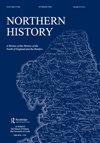IF 0.2
3区 历史学
Q2 HISTORY
引用次数: 0
摘要
例如,海伦·莱西(Helen Lacey)通过各种“诽谤性政治八卦”案例研究了某一特定类型的演讲。她强调了英国当局是如何在“当代对诽谤的敏感性”的大背景下处理这个问题的,特别是在动荡时期(“诽谤国王:14世纪英格兰的不忠言论报道”,第71-93页)。在这些文章中,个人总是出现在他们与政府的联系中。尽管受到失去随从的影响,爱德华三世还是以实际的方式处理了他们的死亡。在《情感实用主义:爱德华三世与死亡》(第39-70页)中,詹姆斯·博思韦尔(James Bothwell)特别研究了葬礼安排和国王家族成员的殓房肖像,并展示了哀悼如何既是个人事务又是公共事务。远离君主制,在与政府结构的关系中出现了两种类型的个人:一种是让国家运作的人,另一种是试图玩弄这个系统的人。第一个是托马斯·霍克列夫。海伦·基利克在《中世纪的“侧客”:托马斯·霍克莱夫在王室内外的职业生涯》(144-163页)一书中回顾了他的职业生涯,并展示了作为一名高级职员,他是如何获得更有趣、更有利可图的写作任务的,以及他是如何有更多时间从事其他文学和抄写活动的。第二个是托马斯·博尔顿,他是1332年国会批准的财政补贴征收的主要税务官,他试图利用职务之便进行欺诈。通过对财政部的回应和对博尔顿的惩罚的分析,乔纳森·麦克曼展示了个人轨迹是如何受到缺钱的王室政治议程的影响的。这些贡献的出发点通常是一个人、一个机构或一个特定的来源,但它们的作者总是设法得出一般性的结论,并让读者对政治文化有一个深入的了解。对于研究中世纪晚期英格兰的人来说,这是一本重要的书,也是对一位伟大历史学家的美好致敬,这位伟大的历史学家去世得太早,但他的遗产将继续流传下去。本文章由计算机程序翻译,如有差异,请以英文原文为准。
DAVID CROUCH (ed.), Howden: Town and Liberty. The Victoria County History of the Counties of England. A History of the County of York: East Riding
For example, Helen Lacey studies a particular type of speech made by subjects through various cases of ‘defamatory political gossip’. She underlines how this problem was handled by English authorities in the general context of ‘contemporary sensitivities to defamation’ and in particular times of unrest (‘Defaming the King: Reporting Disloyal Speech in Fourteenth-Century England’, pp. 71–93). In these essays, individuals always appear in their links to government. Though affected by the loss of members of his entourage, Edward III handled their death with practical sense. In ‘An Emotional Pragmatism: Edward III and Death’ (pp. 39–70), James Bothwell studies notably funeral arrangements and mortuary effigies of members of the king’s familia and shows how mourning could be both a personal and a public affair. Further from the monarchy, two types of individuals emerge in their relationships to the structures of government: there are those who make the State work, and those who try to play with the system. The first is Thomas Hoccleve. In ‘The Medieval “Side-Hustler”: Thomas Hoccleve’s Career in, and out of, the Privy Seal’, pp. 144–163), Helen Killick retraces his career and shows how as a senior clerk he had access to more interesting and lucrative writing tasks and how he had more time for other literary and scribal activities. The second, Thomas Boulton, a chief taxer in charge of the levy of the subside granted by the Parliament in 1332, tried to take advantage of his position to commit fraud. Through the analysis of the responses from Exchequer and the punishment of Boulton, Jonathan Mackman shows how individual trajectories were impacted by the political agenda of a Crown in want of money. The starting point of these contributions is often a person, an institution or a specific source, but their authors always manage to draw general conclusions and to give the reader an insight into political culture. It is an important book for people studying Late Medieval England and a beautiful homage paid to a great historian who died too soon but whose legacy will continue.
求助全文
通过发布文献求助,成功后即可免费获取论文全文。
去求助
来源期刊

Northern History
Multiple-
CiteScore
0.20
自引率
33.30%
发文量
37
期刊介绍:
Northern History was the first regional historical journal. Produced since 1966 under the auspices of the School of History, University of Leeds, its purpose is to publish scholarly work on the history of the seven historic Northern counties of England: Cheshire, Cumberland, Durham, Lancashire, Northumberland, Westmorland and Yorkshire. Since it was launched it has always been a refereed journal, attracting articles on Northern subjects from historians in many parts of the world.
 求助内容:
求助内容: 应助结果提醒方式:
应助结果提醒方式:


